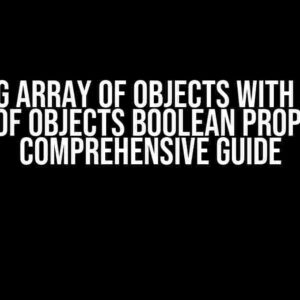Working with nested arrays can be a daunting task, especially when dealing with data scraped from websites using Cheerio. The dreaded “titles and multiple children” conundrum can leave even the most seasoned developers scratching their heads. Fear not, dear reader, for we’re about to embark on a journey to tame the beast of nested arrays and emerge victorious with a flattened, easy-to-manage dataset.
The Problem: Titles and Multiple Children in Cheerio
In Cheerio, when scraping a website, you might encounter HTML structures like the following:
<ul>
<li>
<h2>Title 1</h2>
<ul>
<li>Child 1.1</li>
<li>Child 1.2</li>
</ul>
</li>
<li>
<h2>Title 2</h2>
<ul>
<li>Child 2.1</li>
<li>Child 2.2</li>
<li>Child 2.3</li>
</ul>
</li>
</ul>
This structure represents a nested array of titles and multiple children. Our goal is to flatten this data into a more manageable format.
Why Flatten Nested Arrays?
There are several reasons why flattening nested arrays is essential:
- Easy data manipulation: Flattened data is easier to work with, allowing you to perform operations like filtering, sorting, and aggregation with ease.
- Better data analysis: A flattened dataset enables you to analyze the data more effectively, identifying patterns and relationships that might be obscured by nested structures.
- Improved data visualization: Flattened data is often more suitable for visualization, as it can be easily plotted on charts and graphs.
The Solution: Flatten Nested Arrays with Cheerio
To flatten the nested array, we’ll use a recursive function that traverses the HTML structure and extracts the relevant data. Here’s the code:
const cheerio = require('cheerio');
const html = '<ul>...</ul>'; // your HTML string
const $ = cheerio.load(html);
const flattenArray = (array) => {
const result = [];
array.forEach((item) => {
const title = $(item).find('h2').text();
const children = $(item).find('ul li');
result.push({ title, children: children.map((child) => $(child).text()) });
if (children.length) {
result.push(...flattenArray(children));
}
});
return result;
};
const nestedArray = $('ul li');
const flattenedArray = flattenArray(nestedArray);
console.log(flattenedArray);
This code uses Cheerio to load the HTML string and define a recursive function `flattenArray`. This function takes an array of elements as an argument, extracts the title and children from each element, and recursively calls itself on the children elements. The resulting flattened array is then logged to the console.
Understanding the Code
Let’s break down the code to understand how it works:
- The `flattenArray` function takes an array of elements as an argument.
- It initializes an empty result array `result` to store the flattened data.
- It iterates over the input array using `forEach`, and for each element:
- It extracts the title using `$(item).find(‘h2’).text()`.
- It extracts the children using `$(item).find(‘ul li’)`.
- It creates an object with the title and children, and adds it to the `result` array.
- If the children array is not empty, it recursively calls `flattenArray` on the children array and spreads the result into the `result` array using the spread operator `…`.
- The function returns the flattened `result` array.
Example Output
The output of the code will be a flattened array of objects, each containing a title and an array of children:
[
{ title: 'Title 1', children: ['Child 1.1', 'Child 1.2'] },
{ title: '', children: ['Child 1.1'] },
{ title: '', children: ['Child 1.2'] },
{ title: 'Title 2', children: ['Child 2.1', 'Child 2.2', 'Child 2.3'] },
{ title: '', children: ['Child 2.1'] },
{ title: '', children: ['Child 2.2'] },
{ title: '', children: ['Child 2.3'] },
]As you can see, the nested array has been successfully flattened into a more manageable format.
Common Pitfalls and Optimizations
When working with nested arrays, it’s essential to be aware of potential pitfalls and optimizations:
| P pitfall/Optimization | Description |
|---|---|
| Infinite recursion | Avoid infinite recursion by ensuring that the recursive function has a base case to stop the recursion. |
| Performance optimization | Use techniques like memoization or caching to optimize the performance of the recursive function, especially for large datasets. |
| Data integrity | Ensure that the data is properly sanitized and validated to prevent errors and inconsistencies in the flattened array. |
Conclusion
In conclusion, flattening nested arrays in Cheerio is a crucial step in data scraping and manipulation. By using a recursive function and understanding the underlying HTML structure, you can effortlessly flatten complex data and unlock new possibilities for data analysis and visualization. Remember to avoid common pitfalls and optimize your code for performance and data integrity.
With this comprehensive guide, you should now be equipped to tackle even the most daunting nested arrays and emerge victorious with a flattened, easy-to-manage dataset. Happy coding!
Here are the 5 Questions and Answers about “Flatten nested array of titles and multiple children in Cheerio”:
Frequently Asked Question
Get the inside scoop on how to tackle those pesky nested arrays in Cheerio!
How do I flatten a nested array of titles and multiple children in Cheerio?
You can use the `map` method to iterate over the array and recursively flatten the children. Here’s an example: `const flatArray = array.map(item => [item.title, …(item.children ? item.children.flatMap(flatten) : [])]).flat();`
What if I have multiple levels of nesting? Will this approach still work?
Yes, this approach will still work for multiple levels of nesting. The `flatMap` method will recursively flatten the children until it reaches the deepest level. Just make sure to define the `flatten` function outside the `map` method so it can be called recursively.
Can I use a library like Lodash to flatten the array?
Yes, you can use Lodash’s `flatten` or `flattenDeep` method to flatten the array. Here’s an example: `const flatArray = _.flattenDeep(array.map(item => [item.title, …(item.children ? item.children : [])]));`. However, keep in mind that this will flatten the entire array, including the titles.
How do I preserve the original order of the titles and children?
To preserve the original order, you can use the `reduce` method instead of `map`. Here’s an example: `const flatArray = array.reduce((acc, item) => […acc, item.title, …(item.children ? item.children.flatMap(flatten) : [])], []);`. This will concatenate the titles and children in the original order.
What if I have other properties in my objects that I want to ignore?
You can use the destructuring assignment to extract only the `title` and `children` properties, and ignore the rest. Here’s an example: `const flatArray = array.map(({ title, children }) => [title, …(children ? children.flatMap(flatten) : [])]).flat();`. This will extract only the `title` and `children` properties and flatten the array.



